CHAPTER 9
Your Thyroid Diet Plans
Usually we feel that there’s a large problem and we have to fix it.
The instruction is to stop. Do something unfamiliar.
Do anything besides rushing off in the same old direction, up to the same old tricks.
—PEMA CHODRON
When you’re dealing with a metabolic issue like thyroid disease, as well as many possible impediments to weight loss, finding a successful approach that will work for you is part science, part instinct. You and your body know how to lose weight; it’s just a matter of trying out the likeliest approaches, observing your body’s responses, and monitoring how you feel until you find an approach that works, then tweaking it so that it fits you.
We all know people who stay slender, don’t vary in weight, and let’s face it, we feel green with envy about them sometimes. But if you’re really honest about it, except for the rare freak of nature or teenage athletes with supercharged metabolisms, you will rarely see them wolfing down everything in sight and loading up on junk food. They’ve most likely come up with a way of eating that works for them, and they are usually physically active in some way. My husband is one of these people. At 6'3", with a body mass index around 22, he’s quite trim. His cholesterol is around 160. His blood pressure is 105 over 60. I don’t think he’s varied 5 pounds since I met him. People look at him and say, “Oh, you can eat anything you want and not put on weight,” or “You have such a good metabolism—you’re so lucky.”
But that’s not the case. Yes, he’s fortunate in that he doesn’t appear to have any major metabolic impediments—like a thyroid condition—that make it easier to gain weight than others. But he has also never abused his metabolism (by smoking, or crash dieting, or not eating regularly, or bingeing on junk food), and he has listened to his body and figured out what it needs. He eats to live rather than lives to eat. He doesn’t vary much in what and how he eats. He always has to have a protein, a starch, and fruit for breakfast. He always has veggies or a salad for lunch, with a sandwich. Dinner is a protein, a starch, a salad, and a green vegetable. (If I haven’t made a vegetable, he’ll add raw broccoli to his salad.) At night, his snack never varies—an apple and some peanuts. I tallied it all up one day, and he gets at least 3 servings of fruit and 4 servings of vegetables every day, minimum. And he drinks water all day long—with breakfast, lunch, dinner, his snack, and throughout the day. He doesn’t use mayonnaise or salad dressings, rarely eats sweets, and I think I’ve seen him drink a soda a half-dozen times in 10 years. He has an occasional drink of alcohol but not often. On top of that, he does a bit of walking every day, to and from work, and weekly Pilates sessions, plus some gardening—but he’s far from an exercise hound. When we’ve been on vacation or out for a special night and he’s eaten more treats or junk food than usual, he immediately gets back on track, returning to his usual way of eating.
The key for him is consistency. Almost every day he eats well, in a way that allows him to maintain a healthy weight. And when he has a treat here and there, he just gets back on the program the next day. He’s following what some people call the 90/10 rule of weight management—he maintains healthy eating habits and activity at least 90% of the time, then can splurge 10% of the time.
My husband is not a metabolic miracle; nor is he luckier than anyone else! He simply has found the precise formula that takes care of his body in the best way possible. Your job is to find the system that is going to work best for you.
THE PLANS
I have not set out one specific plan and presented it as the plan that will work for you and everyone else with a thyroid problem, because I’ve discovered that there simply isn’t one plan that will work for everyone. Some thyroid patients are carbohydrate sensitive and find that they can only lose weight when strictly limiting starchy foods. You could just as easily be a thyroid patient who actually gains weight on the low-carb Atkins approach! Or you may be more calorie sensitive and find that you only lose weight when you take your calorie levels lower. Or you may need a very balanced approach of proteins, starches, vegetables, fruits, fat, and so forth.
If all this sounds confusing, relax, because I’ve outlined a number of approaches that you can try. Your objective is to find the plan that works best with your unique metabolism.
WHICH PLAN IS RIGHT FOR YOU?
Complete the following checklists to help determine which one of the plans is the best starting point for you.
____ You have tried one of the low-carb diets like Atkins or South Beach, and you gained weight while following it.
____ You truly enjoy eating vegetables and fruits.
____ You feel your best after a meal that contains protein, starch, and some vegetables or fruit.
____ You need variety in your diet.
If you checked two or more of the above statements, then you should start with the Free-Form Plan.
____ You frequently crave things like pasta, bread, rice, potatoes, and sweet desserts.
____ Once you get started eating things like pasta, bread, rice, potatoes, and sweet desserts, you find it hard to stop.
____ After you eat things like pasta, bread, rice, potatoes, and sweet desserts, you find yourself feeling hungry again fairly quickly.
____ You find that after you eat a piece of cake or a bowl of pasta, you temporarily end up a pound or two heavier on the scale the next day.
If you checked two or more of the above statements, then it’s likely that carbohydrates are a problem for you. You should start with the Carb-Sensitive Plan.
____ You have tried a diet like Weight Watchers and gained weight while following it.
____ You have tried a low-carb diet like Atkins and gained weight while following it.
____ You suspect that you probably eat too much, but you don’t keep track.
____ You find that you can gain weight on what others would consider cutting back or a diet.
If you checked two or more of the above statements, then you should start with the Calorie-Sensitive Plan.
If you found yourself agreeing with many of the statements in all of the categories, then start out with the Free-Form Plan.
While the checklists can help you choose a plan to start with, read through all the plan guidelines. You will probably have an instinctual sense of which plan may be the best for you to try first. If you really listen, you know your body better than you think.
Foods, some suggested menus, and a variety of tasty, healthful recipes are featured in chapter 10. You’ll find that those guidelines will help you follow the plan of your choice more easily.
Follow the plan suggested by your checklists, or try whichever plan makes the most sense for you. Give it at least 4 weeks. I mean it—4 weeks. I know the temptation is to try it for 4 days, and if you don’t notice the scale going down, you’ll abandon it for the next plan. But give it 4 weeks. See how you do. Note how you feel. Keep a food journal and track types of foods, carbohydrate intake, fat (including saturated fat), your moods, exercise level, menstrual periods, water, supplements, and daily weight so that you can see how you’re doing and what might be affecting your weight.
After 4 weeks, if you’ve lost a few pounds (and remember, when you’re dealing with a thyroid problem, consider it a resounding success if you have lost 1 pound in a week!) you’ll want to stick with the plan you’re on. But go back and look at the notes you’ve kept. Did you find that you didn’t have any weight loss on the days after you ate dairy, or you even bloated up and gained a bit? Think about cutting down on dairy as you move forward. Did you notice that if you met your water goals one day, the next day you saw some weight loss on the scale? This tells you that you really need to keep your water level high. In contrast, if you felt terrible quite a bit of the time, or haven’t lost anything or even gained weight, then try one of the other plans. And give that plan 4 weeks.
I’m not offering a quick fix. If there were a miracle diet, you and I wouldn’t need to be here. It usually takes quite a bit of time to become hypothyroid and for metabolism to get off track. It can take just as much time or more to get your thyroid back toward balance and help reenergize your metabolism so that you start losing weight. And once you’re hypothyroid, you’re likely to remain that way, so we’re looking for a way of eating that is going to work for life.
But have faith. You will find that one of the following plans contains an approach that will work for you!
THE FREE-FORM PLAN
The free-form plan is straightforward and gives you quite a bit of leeway. It’s a balanced, healthy starting point. If you already know you are extremely carbohydrate sensitive, this may not be the place to start, but if you’re not sure, this is a good plan to follow.
- Eat 3 meals a day.
- Protein—each meal should include 1–2 portions of lean protein.
- Low-glycemic vegetables—eat all you want, and make sure you’re getting at least 6 servings a day.
- Low-glycemic fruits—1–2 servings a day maximum.
- Low-glycemic starches—2–3 servings a day maximum.
- Good fat—a small serving with each meal and snack.
- Snacks—1–2 per day if needed (but avoid eating after 8 P.M.).
- Treats—very sparingly; maybe a small serving once or twice a week at most.
- Water—64 ounces, minimum.
- Supplements—your choice as per your practitioner’s recommendation.
- Fiber—25 grams, minimum.
You don’t need to count calories with this diet, but focusing on lean proteins, plenty of vegetables, good fats, and limited starches and fruits naturally keeps the calories at a healthy level.

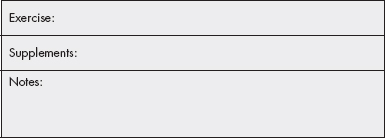
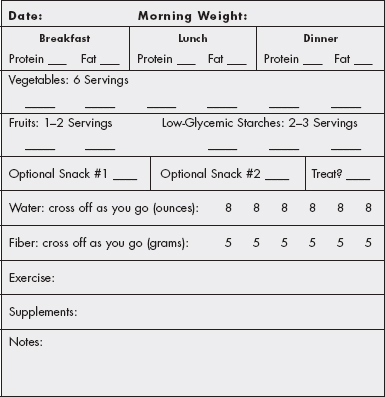
CARB-SENSITIVE PLAN
- Eat 3 meals a day.
- Protein—each meal should include 1–2 portions of lean protein.
- Low-glycemic vegetables—eat all you want, and make sure you’re getting at least 6 servings a day.
- Low-glycemic fruits—1 serving a day.
- Low-glycemic starches—1–2 servings a day.
- Good fat—a small serving with each meal and snack.
- Snacks—1–2 per day if needed (but avoid eating after 8 P.M.).
- Treats—very sparingly; maybe a small serving once or twice a week at most (and avoid carbohydrate treats).
- Water—64 ounces, minimum.
- Supplements—your choice as per your practitioner’s recommendation.
- Fiber—30 grams, minimum.
While you don’t want to go overboard calorie-wise on the carb-sensitive plan, you don’t have to be particularly concerned about calories. One pilot study followed three groups: one on a low-fat controlled-calorie diet, the second on a low-carbohydrate diet at the same calorie levels, and the third on a low-carbohydrate diet at 300 more calories per day. Statistically, all the groups lost about the same amount of weight, despite the fact that the third group technically should have lost 7 pounds less than the other groups, if you follow the 3,500 calories equals 1 pound dictum.
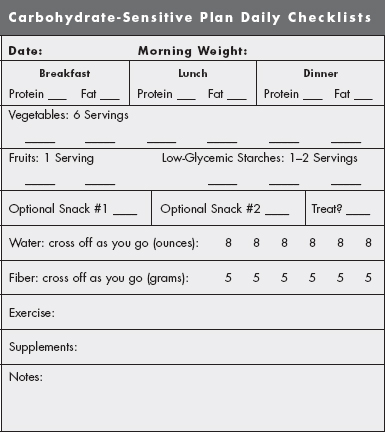


THE CALORIE-SENSITIVE PLAN
Some people simply can’t lose weight without cutting calories. With the calorie-sensitive plan, you’ll need to do more tracking of foods, so you may want to invest in one of the computer programs or tools—like Diet Power or the Personal Food Analyst—that will help you keep track of your intake fairly closely.
Your aim is to stay within your calorie target, getting approximately 35% of your calories from lean protein, 20% from low-glycemic vegetables, 15% from low-glycemic fruits and starches, and 30% from good fats.
How Many Calories Do You Need?
The number of calories you need should take into account height, weight, and age. One way to calculate your basal metabolic rate (BMR) caloric intake is with the Harris-Benedict equation, which differs for men and women:
Men: BMR= 66 + (13.7 × weight in kilograms) + (5 × height in centimeters)-(6.8 × age in years)
Women: BMR = 655 + (9.6 × weight in kilograms) + (1.8 × height in centimeters)-(4.7 × age in years)
Note: To calculate your weight in kilograms, divide your weight in pounds by 2.2. To calculate your height in centimeters, multiply your height in inches by 2.54.
Here’s how it works for a 200-pound person who is 5'8" and 45 years old.
200 pounds is 90.9 kilograms (200 ÷ by 2.2)
68 inches is 172.72 centimeters (68 × 2.54)
Age 45
Man, 200 pounds, 5'8"
66 + (13.7 × wt in kg) + (5 × ht in cm)-(6.8 × age in yrs)
66 + (13.7 × 90.9) + (5 × 172.72)-(6.8 × 45)
66 + 1245.5 + 863.6 + 306.0 = 1,869 calories
Woman, 200 pounds, 5'8"
655 + (9.6 × wt in kg) + (1.8 × ht in cm)-(4.7 × age in yrs)
655 + (9.6 × 90.0) + (1.8 × 172.82)-(4.7 × 45)
655 + 872.7 + 310.9-211.5= 1,627 calories
Unless you are unusually active, meaning you work out at least 1 hour four times a week or more, this level of calories should be your target level. (If you do work out more than this, multiply the calorie level by a factor of 1.3 to take into account your workouts.) If you don’t see any weight loss within 2 weeks, try cutting another 150 calories and see if that triggers weight loss over a 2-week period.
MEN’S CALORIE WORKSHEET
Men: How Many Calories Do You Need?
Basal Metabolic Rate = 66 + (13.7 × wt in kg) + (5 × ht in cm)(6.8 × age in yr)
|
Your Weight in Pounds |
_______ |
|
Divide by 2.2 |
_______ |
|
= Your Weight in Kilograms |
_______ |
|
Your Height in Inches |
_______ |
|
Multiplied by 2.54 |
_______ |
|
= Your Height in Centimeters |
_______ |
|
Your Age in Years |
_______ |

WOMEN’S CALORIE WORKSHEET
Women—How Many Calories Do You Need?
Basal Metabolic Rate = 655 + (9.6 × wt in kg) + (1.8 × ht in cm)(4.7 × age in yr)
|
Your Weight in Pounds |
_______ |
|
Divide by 2.2 |
_______ |
|
= Your Weight in Kilograms |
_______ |
|
Your Height in Inches |
_______ |
|
Multiplied by 2.54 |
_______ |
|
= Your Height in Centimeters |
_______ |

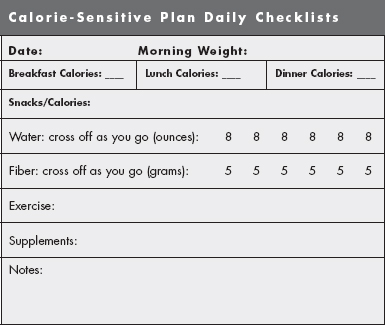
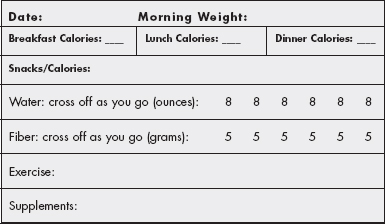

TWEAKING YOUR MEALS AND FOODS
One of the key ways you’ll be working with your diet is to tweak your plan to make sure it fits you perfectly and helps you lose weight. For example, you may find that you are losing weight but extremely slowly. Don’t abandon that plan and start a different one, hoping you’ll lose pounds more quickly! If you are losing, you are on the right track. Instead, consider making some modifications to your plan to see how you respond.
Don’t make all the modifications at once, however, or you won’t know which change is working. After you make a modification, allow yourself at least a week before you decide to abandon it, adopt it permanently, or try another modification or plan. Some of the most helpful tweaks to your plan might be the following:
- Up the water—your body needs a constant, steady source of water in order to flush out toxins and fat, and to keep metabolism functioning smoothly. So if you’re drinking 64 ounces a day, try adding three to five more 8-ounce glasses so that you’re drinking 88 to 104 ounces of water. And if you’re drinking more than 100 ounces a day, try working you way up to drinking your body weight in ounces of water.
- Cut back on starches—some people are so sensitive to starchy carbohydrates that if they eat any, they can’t lose much weight at all. Whatever plan you are on, one option is to drop one serving of starchy carbs each day to see what happens.
- On a calorie-sensitive plan, cut calories—sometimes, the difference between stalling out and losing weight is a matter of a few calories. If you’re on the calorie-sensitive plan, cut 50 or 100 calories a day. It may mean the difference between losing and staying where you are.
- Drop your snacks—if you’re a veteran snacker, consider dropping your snacks. Try focusing on eating a larger breakfast and a slightly larger lunch.
IMPLEMENTING YOUR PLAN
What Is Your Optimal Weight?
I can’t tell you at which weight you’ll feel the best, and there are many different expert opinions. One of the simplest formulas is this: for women, allow 100 pounds for the first 5 feet and 5 pounds for each additional inch; for men, allow 110 pounds for the first 5 feet and 5 pounds for each additional inch. More sophisticated charts differentiate between frame size, by gender and height.

Ultimately, I know you have a number in your mind. It may be based on the above charts and calculations. More likely, it is based on a weight at which you felt and looked your best in the past. Now, I want you to put that number in the back of you mind. It may be your final goal, but you need to set realistic goals along the way.
Body Mass Index
To set your initial goals, you need to know your body mass index (BMI). A rough calculation of your BMI is your weight in pounds divided by your height in inches squared (lb/in2) multiplied by 703. Here’s an example:
Suppose you are 5'8" and weigh 200 pounds.
There are 12 inches in a foot, so 5 feet in inches is 5 × 12, or 60. Since you’re 5'8", we need to add 8 inches, so your height in inches is 68.
68 squared (68 × 68) equals 4,624.
Take your weight, 200, and divide it by 4,624.
That’s 0.0432525951557093.
Now multiply by 703.
That equals 30.4065743944637.
So, rounded off, your body mass index would be 30.4.
BODY MASS INDEX CHART
|
Healthy weight BMI |
18.5–25 |
|
Overweight BMI |
26–30 |
|
Obese BMI |
31–40 |
|
Morbidly obese BMI |
Above 40 |
In our example, a 200-pound person who is 5'8" with a BMI of 30.4 would be considered overweight to slightly obese.
In addition to the calculation method, the following BMI table can help you. There are also numerous online calculators where you enter your height and weight, and your BMI is calculated. I have one on my site at http://www.goodmetabolism.com.
BODY MASS INDEX (BMI) FOR ADULTS

Source: Centers for Disease Control and Prevention, National Center for Chronic Disease Prevention and Health Promotion, Division of Nutrition and Physical Activity.2003
If you belong to a gym, work with a fitness trainer, or see a nutritional expert, they can also perform more detailed BMI calculations that take into account important fat measurement spots. The online PhysiqueTransformation.com site has a fairly detailed online BMI calculator that tracks waist and wrist measurements in addition to height and weight if you want even more accuracy.
Excess fat in the abdominal area is a risk factor for insulin resistance and other diseases. The waist measurement at which there is a definite increase in risk is 40 inches or more for men and 35 inches or more for women.
Setting Realistic Goals
- Phase 1/Goal 1: If you have a BMI over 30, your first goal should be to lose enough weight to get into the BMI range of 25–29. This will automatically reduce the risk of various diseases and help make your metabolism more efficient. You should also target a waist measurement reduction of 5%.
- Phase 2/Goal 2: If you’re in the 25–29 level (or you’ve lost enough weight in phase 1), then your goal should be to get down to a BMI of just below 25. At this point, you are no longer overweight. You have greatly reduced health risks, improved your metabolism, no doubt look like a different person, and have more energy and greater fitness.
- Phase 3/Goal 3: If your ultimate goal weight is less than where you are with a BMI of a little less than 25, then keep working on weight loss until you reach that objective.
In each phase, you should target a 5% reduction in waist measurement. The following chart may be a help:
Waist Measurement Reduction Targets
|
Waist |
Phase I |
Phase II |
Phase III |
|
28 |
27 |
25 |
24 |
|
29 |
28 |
26 |
25 |
|
30 |
29 |
27 |
26 |
|
31 |
29 |
28 |
27 |
|
32 |
30 |
29 |
27 |
|
33 |
31 |
30 |
28 |
|
34 |
32 |
31 |
29 |
|
35 |
33 |
32 |
30 |
|
36 |
34 |
32 |
31 |
|
37 |
35 |
33 |
32 |
|
38 |
36 |
34 |
33 |
|
38 |
36 |
34 |
33 |
|
40 |
38 |
36 |
34 |
|
41 |
39 |
37 |
35 |
|
42 |
40 |
38 |
36 |
|
43 |
41 |
39 |
37 |
|
44 |
42 |
40 |
38 |
|
45 |
43 |
41 |
39 |
Let’s use our previous example of a 5'8" person who is 200 pounds. Current BMI is 30.4. At a weight of 180, the BMI would be27. So 27 is overweight but not obese, and it’s a great first goal. That would be a target weight loss of 20 pounds, or 10% of body weight.
During phase 1, be realistic and assume it will take at least a week to lose a pound, so a 20-pound weight loss would probably take you at least 20 weeks, or about 5 months.
The next target should be a BMI of 24, or 160 pounds. That’s another 20 pounds, or about 11% of body weight. At this point, your metabolism may be more efficient, and you are hopefully getting more activity and exercise, so weight loss could go faster—maybe 1½ pounds a week. Or it could stay at around 1 pound per week, so count on another 13 to 20 weeks, or 3 to 5 months.
At this point, you will be 160 pounds, and a normal weight according to BMI. But you may still want to go a bit further. If you’re a woman, you may feel that you would look your best at around 145 pounds (which would be a very lean BMI of 21). So that’s still another 15 pounds, or around 10% of your body weight to go. Figure on another 15 weeks, or 4 months. If you’re a man, you might feel like you’ll look your best at 150—a BMI of 23—in which case you only have 10 more pounds to go, or another 10 weeks. Figure on 2 to 3 months.
So within about a year, you are lean and healthy and have reached your goal! And most importantly, you have learned how to eat and exercise to stay that way!
SPECIAL GUIDELINES FOR THYROID DIETERS
No matter which plan you choose, when you are following a weight-loss program there are some considerations you need to keep in mind that apply specifically to you as a thyroid patient.
Patience! Patience! And More Patience!
You are going to need a great deal of patience and perseverance, because even if you are doing everything right diet-wise, weight loss may go far more slowly than you would like. Celebrate your resounding success even if you lose a pound a week. Do not compare your results with anyone else.
Although many diet programs recommend that you diet with a buddy, this is one time when it might be better not to unless he or she is hypothyroid, too. Because people with normal thyroid function are likely to lose weight faster than you. Not fair, but a fact of life. So keep the faith, and don’t let slow progress make you lose your determination to stick with the program!
Exercise
Don’t forget that you have to exercise. It’s not optional. Weight-bearing/muscle-building exercise is critical to raising metabolism. And aerobic exercise helps burn calories.
Some diets and weight-loss programs tell you that you can lose weight without exercise. That may be true for some people and some programs. But it’s not likely to be true for most thyroid patients. And what those diet programs don’t tell you is that most people who are not exercising will eventually regain the weight over time. Even if you’re not a big fan of physical activity, you’ll have to accept it: exercise is not optional.
Retesting
You will probably be adding fiber to your diet, so you should have your thyroid function retested about 6 to 8 weeks after you stabilize at your new level of fiber intake. You may need a change in your dosage of thyroid hormone replacement. Also, if you lose more than 10% of your body weight, that is also a time to get retested to see if you need a dosage adjustment.
All this retesting can become costly. So consider home testing using a Biosafe home TSH test kit (http://www.thyroid-info.com/tsh test.htm or 1-800-768-8446, extension 123), or have your blood drawn at a nearby lab without your doctor’s office markup and without requiring a doctor’s visit, and let Healthcheck USA process the results (http://www.healthcheckusa.com or 1-800-929-2044).
Watch Those Starchy Carbs!
Many thyroid patients report that they are only able to lose weight when they dramatically cut down on starchy carbohydrates—like bread, sugar, pasta, sodas, and desserts—and limit carbs mainly to vegetables with some fruit. While there are thyroid patients who process carbs with no difficulty and can lose weight on a more old-fashioned food pyramid diet that emphasizes cereals, grains, and bread, they seem to be the exception rather than the rule.
Keep Protein Intake Higher to Protect Hair
Hair loss is a concern for many thyroid patients, and some who start a weight-loss program will find that hair loss increases. Frequently, this is a sign of protein deficiency. Some experts, for example, say protein intake should be as much as 0.5 grams for each pound of body weight. Try to emphasize low-fat, protein-dense food sources, like fish, bison/buffalo, or lean cuts of meat and poultry.
Try One Thing at a Time
There’s a tendency to want to try everything at the same time, but then it’s hard to tell what is actually working. It’s better to implement changes more slowly so that you can gauge what works. For example, start with dietary changes. After a few weeks, if you feel that you’ve found a decent way of eating, try one supplement to see if it helps speed weight loss, or curbs cravings, or reduces hypothyroid symptoms. If a particular supplement helps, you may want to try another as well. (But trying too many at the same time means you won’t know which ones are really working.) Then add exercise. (Weight-bearing exercise replaces fat with muscle. Muscle takes up far less space than fat, so you may lose fat, gain muscle, and show less change on the scale than you do in terms of inches lost.) Ultimately, you’ll arrive at a combination of approaches that will work best for you.
Measure Regularly
Hopping on a scale to keep track of weight loss is important but not as important as keeping track of measurements. Particularly for thyroid patients, who may have more early results in building muscle than in losing pounds, keeping track of measurements can provide important feedback and may even provide incentive on those days or weeks when you don’t see much movement on the scale.